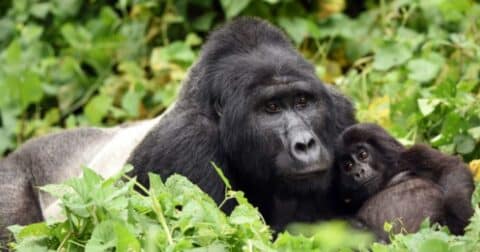News
Could Genetically Engineered Fungus Help Replace Animal Protein?
Breakthroughs•5 min read
Explainer
These species show that engaged fatherhood can be perfectly natural.


Words by Seth Millstein
In the animal kingdom, there are about as many different kinds of parenting strategies as there are animals. From group parenting to lifelong parenting to no parenting at all, the animals of the world have found countless ways to ensure that their offspring survive and thrive. Contrary to popular assumption, this often involves the dad playing a key role in parenting. So, in honor of Father’s Day, let’s have a look at some of the most striking father-child bonds in the animal kingdom.
We’ve already looked at the extraordinary lengths animal moms go to care for their children, but plenty of animal dads play active roles in raising their young, too. In some species, this means guarding their offspring and providing protection; in others, it means incubating eggs, monitoring offspring’s hunger levels or teaching them how to hunt. Some fathers even go the extra distance, and raise their offspring entirely by themselves.
A tiny primate native to southeastern Brazil, the golden lion tamarin is named for its impressive orange mane. Also impressive is how committed golden lion tamarin fathers are to caring for their children.
Golden lion tamarin mothers typically give birth to twins, and as soon as the babies are able, they climb onto their dad’s back and cling to him. For several weeks, they’ll spend almost every moment piggybacking on dad; every few hours, he hands off one of his kids to their mother, who will nurse them for fifteen minutes before returning them to dad’s back.
Once his children are able to eat soft food, the tamarin dad will peel, mash and feed bananas to them by hand. Although golden lion tamarins are able to care for themselves after 3-5 months, they often continue to visit their parents for some time thereafter; much like humans, they’re most likely to do this to ask for food, or if they’re in some kind of danger.
While many people might think of gorillas as loud and aggressive, males of the species have a softer side as well. Male gorillas spend a lot of time playing with the infants in their social groups, regardless of whether the infants in question are their own children. They’re very tolerant of baby gorillas’ childlike antics; even if they’re preoccupied with another task, male gorillas will let the infants climb on their shoulders, use them for shade, and so on.
What’s interesting is that according to one study, the amount of time a male gorilla spends babysitting infants is highly correlated with how many children he will end up having. A study of a gorilla group in Rwanda’s Volcanoes National Park found that the males who spend the most time playing with babies ended up having 5.5 times as many offspring as those who spent the least.
Although the reason for this isn’t fully understood, researchers have speculated that female gorillas are more attracted to males who babysit, as this suggests that they’ll be good fathers.
Red fox fathers are highly involved in raising their children. For the first month after a litter is born, they go out every six hours to hunt for food for his family as the mother tends to the newborns. For the next few months after that, he’ll play with his kids constantly — while gradually reducing their food supply.
He does this not to starve his kids, but rather, to prevent them from becoming too dependent on their parents for food. But he doesn’t leave them high and dry; instead, he’ll bury food under sticks and twigs near the family home, and teach his kids how to forage.
This is similar to the behavior of the swift fox, a closely related species. Because swift foxes often have to contend with coyotes, males will sometimes play “ambush” with their children in order to teach them how to evade predators.
The bonding between a mimic poison frog father and his kids begins before they’re even born, as he tends to their unhatched eggs after fertilizing them to make sure they’re developing healthily. Once they hatch, he loads them onto his back one at a time, finds a small pool of water for each of them to live in, and deposits each tadpole in its new home one by one.
Over the next several weeks, dad makes the rounds, checking on his babies to make sure they have enough food and water. When one of them is hungry, dad alerts mom, who comes to the pool and deposits a single, unfertilized egg for the tadpole to eat. If the pool dries up, dad loads the tadpole back onto his back and finds another place for him to live.
When a female emperor penguin lays an egg, it’s her mate who takes on incubation responsibilities, carefully cradling the egg between his feet and belly for two months straight as mom leaves the nest to stock up on food. During this time, the dad doesn’t eat anything, instead relying on his fat reserves and snow to survive. Often, multiple incubating dads in a colony will huddle together for warmth, rotating their positions to ensure none of them get too cold.
By the time mom returns, the egg will have hatched, and she’ll feed the newborn by regurgitating the food she’s eaten over the last 65 days. At that point, the dad finally gets a break from childcare duties, and goes out to feed himself, while mom provides the baby with warmth.
This cycle repeats itself for almost two more months, at which point the chick starts to become more independent. By six months, they’ll be able to hunt for food and stay warm without their parents’ help.
These flightless Australian birds can grow up to six feet tall, and while they’re generally peaceful, males have been known to attack humans if they feel their chicks are threatened.
That’s not the only way in which cassowary fathers protect their young. After a female cassowary lays her eggs, she trots off into the woods to find another male to mate with, never to be seen by her family again. The father, meanwhile, is left to incubate the eggs by himself, which he does for around 50 days before they hatch.
This is no easy task; because of how large they are, the eggs must be rotated four times a day to ensure that they stay warm. When they’ve finally hatched, the father spends the next 9-18 months raising his chicks as a single dad, teaching them how to forage and, when they’re very young, breaking up fruit into small enough pieces for them to eat.
All of the above species are examples of biological fathers taking an active role in child rearing, but we’d be remiss if we didn’t recognize nature’s stepdads as well.
In normal circumstances, male chimpanzees don’t play any role in raising their offspring. But when a baby chimp’s mother dies prematurely for one reason or another, it’s not uncommon for adult male chimps to adopt them, and raise them just as a mother chimpanzee would her own young: carrying them on his back, sharing food with them, making sure they don’t get lost and protecting against predators. These adoptive relationships can sometimes last for years — even when the two chimps have no blood relation at all, which is frequently the case.
Because stepdad chimps spend significant time and energy protecting their adoptive children without deriving any clear benefit themselves, this chimpanzee behavior has been cited as an example of true altruism in the animal kingdom.